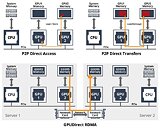
GIGABYTE Introduces a Broad Portfolio of G-series Servers Powered by NVIDIA A100 PCIe
GIGABYTE, an industry leader in high-performance servers and workstations, announced its G-series servers' validation plan. Following the NVIDIA A100 PCIe GPU announcement today, GIGABYTE has completed the compatibility validation of the G481-HA0 / G292-Z40 and added the NVIDIA A100 to the support list for these two servers. The remaining G-series servers will be divided into two waves to complete their respective compatibility tests soon. At the same time, GIGABYTE also launched a new G492 series server based on the AMD EPYC 7002 processor family, which provides PCIe Gen4 support for up to 10 NVIDIA A100 PCIe GPUs. The G492 is a server with the highest computing power for AI models training on the market today. GIGABYTE will offer two SKUs for the G492. The G492-Z50 will be at a more approachable price point, whereas the G492-Z51 will be geared towards higher performance.
The G492 is GIGABYTE's second-generation 4U G-series server. Based on the first generation G481 (Intel architecture) / G482 (AMD architecture) servers, the user-friendly design and scalability have been further optimized. In addition to supporting two 280 W 2nd Gen AMD EPYC 7002 processors, the 32 DDR4 memory slots support up to 8 TB of memory and maintain data transmission at 3200 MHz. The G492 has built-in PCIe Gen4 switches, which can provide more PCIe Gen4 lanes. PCIe Gen4 has twice the I/O performance of PCIe Gen3 and fully enables the computing power of the NVIDIA A100 Tensor Core GPU, or it can be applied to PCIe storage to help provide a storage upgrade path that is native to the G492.
The G492 is GIGABYTE's second-generation 4U G-series server. Based on the first generation G481 (Intel architecture) / G482 (AMD architecture) servers, the user-friendly design and scalability have been further optimized. In addition to supporting two 280 W 2nd Gen AMD EPYC 7002 processors, the 32 DDR4 memory slots support up to 8 TB of memory and maintain data transmission at 3200 MHz. The G492 has built-in PCIe Gen4 switches, which can provide more PCIe Gen4 lanes. PCIe Gen4 has twice the I/O performance of PCIe Gen3 and fully enables the computing power of the NVIDIA A100 Tensor Core GPU, or it can be applied to PCIe storage to help provide a storage upgrade path that is native to the G492.







